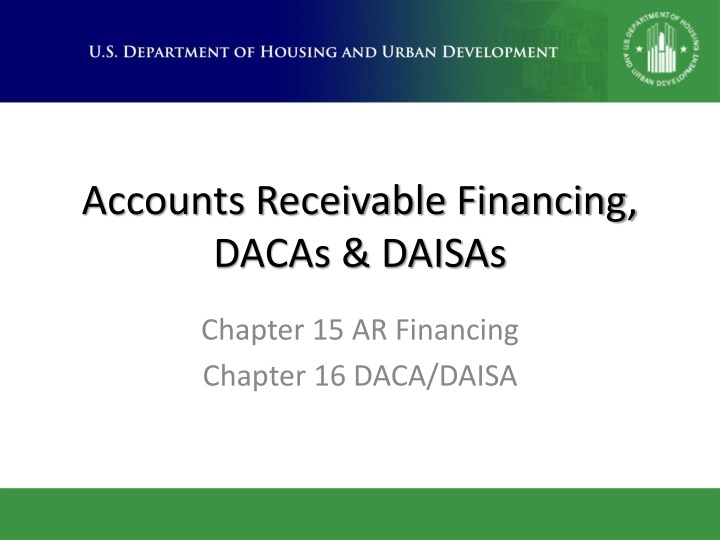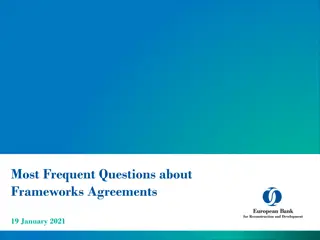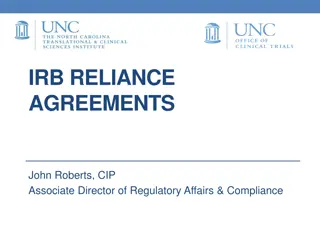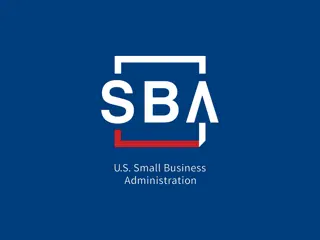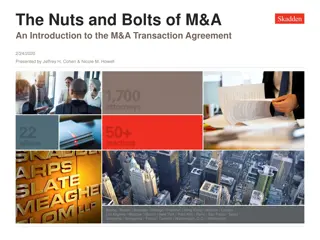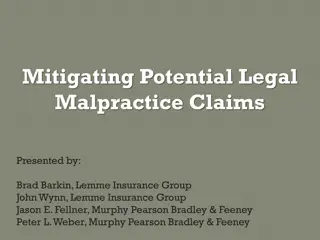Overview of Accounts Receivable Financing and Intercreditor Agreements
Explore the world of Accounts Receivable Financing (AR) and the significance of Intercreditor Agreements (ICA) in the financial industry. Learn about the evolution of AR Financing agreements and the key changes introduced in different versions. Understand the critical aspects of transitioning to new documents and the requirements for implementing substantial changes in AR lines. Discover the essential role of cash flow charts and structures in AR financing.
Download Presentation

Please find below an Image/Link to download the presentation.
The content on the website is provided AS IS for your information and personal use only. It may not be sold, licensed, or shared on other websites without obtaining consent from the author.If you encounter any issues during the download, it is possible that the publisher has removed the file from their server.
You are allowed to download the files provided on this website for personal or commercial use, subject to the condition that they are used lawfully. All files are the property of their respective owners.
The content on the website is provided AS IS for your information and personal use only. It may not be sold, licensed, or shared on other websites without obtaining consent from the author.
E N D
Presentation Transcript
Accounts Receivable Financing, DACAs & DAISAs Chapter 15 AR Financing Chapter 16 DACA/DAISA
AR Financing New Intercreditor Agreement March 2013 new documents published including the Intercreditor Agreement (ICA) AR industry strongly opposed the published ICA Formed a Task Force to revise document Revision became available for use on February27, 2014 Final OMB-numbered form HUD-92322-ORCF now available on HUDClips
AR Financing New Intercreditor Agreement February 2014 changes include: Definition of AR Loan Obligations Cut-Off Time & Ceased Funding Notices and Consent Rights
AR Financing New Intercreditor Agreement June 2014 changes includes: Standstill provision Clarifies that no changes are permitted to the remittance instructions until AR lender is paid in full.
AR Financing New Intercreditor Agreement Cross-default is not permitted between HUD AR line and non-HUD AR lines Policy since the document was implemented on July 12, 2013, and all subsequent revisions
AR Financing Transitioning to New Documents New Document Implementation matrix on www.hud.gov Adding project(s) to existing line no major changes to the existing line may use OLD documents
AR Financing Transitioning to New Documents Substantial change to the AR line requires use of NEW documents: adds an interest reserve to the AR loan increases the interest rate (other than variable interest rate provisions) increases the Maximum Commitment Amount of the AR loan by 15% or more amends or expands the type of obligations secured by the AR loan changes any term or condition that might be deemed substantial at the sole discretion of HUD
Cash Flow Charts Lender must submit a cash flow chart 16.3 describes Cash Flow Charts 16.4 describes Cash Flow Structures See also the Legal Punchlist for required elements Appendix 16 sample Cash Flow Charts.
DACAs and DAISAs Deposit Account Control Agreements (DACA) Non-government receivables Control agreement Deposit Account Instruction Service Agreements (DAISA) Government receivables Sweep instructions See 16.1
DACAs and DAISAs There is no standard HUD form DACA or DAISA, but certain key terms must be included in both documents: 16.6(C) DACA s; 16.7(A) DAISA s; Legal Punchlists
Commingled Accounts If a commingled account is proposed, the parties must demonstrate the following: Systems in place that identify all funds; Operator financial reporting as required by 24 CFR 5.801; Not permitted to commingle FHA-insured with non-FHA-insured projects Subject to HUD s written approval See 16.4(G) and Appendix 16.4.
DACA Detail General parameters 16.6(A) Key elements 16.6(C) Parties Notification of security interest No other DACAs Accounts covered UCC language Giving notice of control Implementing control notice Set-off, recoupment Terminating a DACA Types of DACAs 16.6(B): 1. Future notification 2. Immediate control
DAISA Detail Key elements 16.7(A) Parties to a DAISA Notification of security interest No DACAs Accounts covered Sweep instructions Set-off, recoupment Termination of a DAISA
Key Elements for Both DACA and DAISA Access to account Account maintenance requirements Minimum balance requirements Conflicts Bank fees Indemnification Boilerplate Assignment (See 16.8)
